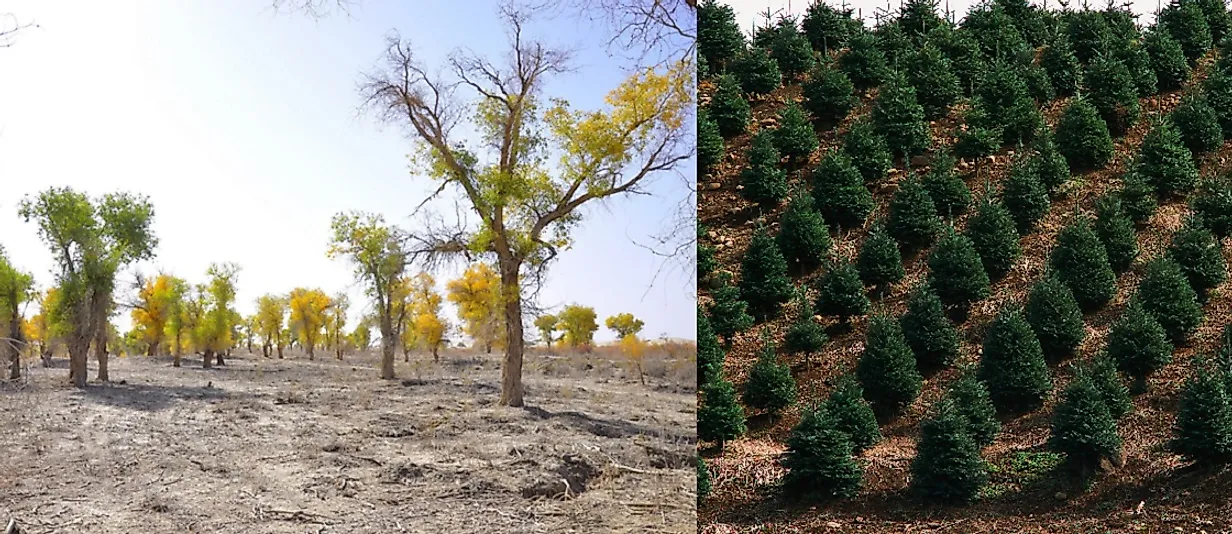Afforestation And Reforestation

5. Defining Afforestation And Reforestation
Both afforestation and reforestation involve growing trees to establish a forest cover on non-forested ground. According to the Intergovernmental Panel for Climate Change (IPCC), reforestation is the establishment of forest cover in a place, where the forests have been cleared away in the recent past to make way for some other land use such as agriculture or mining. Afforestation on the other hand is establishment of a forest cover in an area without forests, or an area without forest cover for a very long period of time. The IPCC definition involves direct tree planting by human agents. However, others recognize establishment of tree cover by natural processes of regeneration as well.
4. Notable Examples, Past And Present
The Green Belt Movement was founded by Nobel laureate Wangari Maathai in 1977, wherein 51 million trees were planted in Kenya, and is one of the best known examples of afforestation.
In Korea, the 35 year occupation by Japan had left large tracts of its forests logged. National and local governments undertook a massive tree planting program starting in 1961 that had added 11 billion trees by 2008. South Korea is now even helping arch enemy North Korea in their effort in reforestation.
The Kwimba Reforestation Project was commenced in 1990 to increase tree cover previously lost due to local use for firewood in Tanzania. With multinational and multi-organizations' help, 6.4 billion trees were planted.
Jesús León Santos, a Mexican farmer and environmentalist, established the Center for Integral Small Farmer Development in the Mixteca (CEDICAM), where tree planting was used to restore soil as part of a project aiming to grow crops with traditional methods. More than 1,000 hectares were planted with one million trees.
Starting in 2002, the Samboja Lestari project in East Kalimantan, Indonesia has restored an important 2,000 hectare orangutan habitat. The habitat and replanting also provides employment to 3,000 people.
The Appalachian Regional Reforestation Initiative (ARRI) is planning on reclaiming more than 70,000 hectares of mined land in the Eastern United States with 7 billion trees. By 2011, 60 million trees had been planted on 35,000 hectares.
3. Environmental Benefits
One of the main benefits of increasing tree cover, and outcomes which are also effective globally, is carbon sequestration, wherein green house gases such as carbon dioxide are absorbed by flora, leading to climate change mitigation. Tree planting also leads to purifying air. Increasing forest cover especially by afforestation, helps to reduce soil erosion and water runoff. The soil fertility can in time be restored bringing in new plants and trees, increasing the plant diversity. As important host plants are established, birds, insects and other dependent animals take residence in the area, improving the biodiversity of the place. Soil restoration also helps agriculture. When water run-off is prevented, it has time to seep into the soil, recharging ground water aquifers, improving water supply for humans, plants and animals.
2. Economic Benefits
Reforestation is a means to grow trees that can be harvested for timber and firewood. When reforestation and afforestation recharge ground water sources, they can improve water supply from wells for agriculture or provide safe water for drinking and household uses. With two-thirds of the world's population dependent on wells for their water supply, water scarcity is one of the greatest challenges facing the world. One in ten person has no access to safe water, so human living standards can be greatly improved by planting trees. Afforestation can create forests that can support livelihoods especially in developing and least developed countries, as 1.6 billion people worldwide rely on forests for livelihoods. New forests can also be sites for recreation, bringing in revenue for locals.
1. Prospective Obstacles and Disadvantages
There are limited funds to grow trees and reestablish forests, and doing so is a long-term investment. According to the Food and Agriculture Organization, during the long maturation time, tree planting projects face many risks such as natural hazards and conflicting land use. Local and social participation is important, as are legal issues of ownership of trees and benefit sharing among local inhabitants, which have to be taken into account, to make any tree-planting program a success. There are also conflicting interests in tree planting, and a trade-off exists between its use for carbon sequestration and for livelihood concern.











